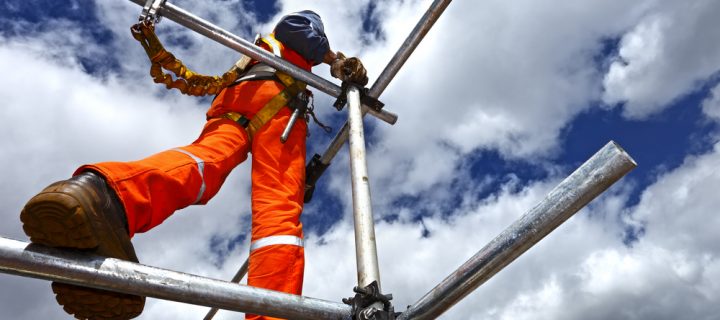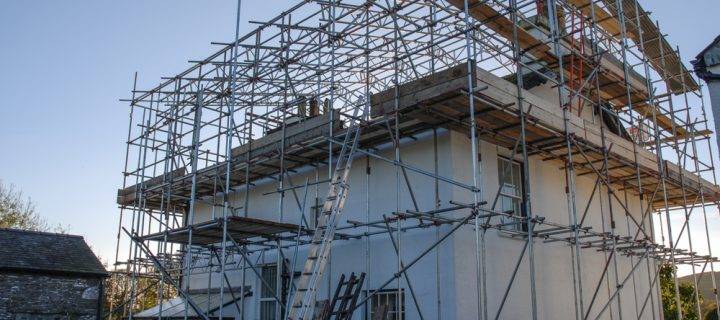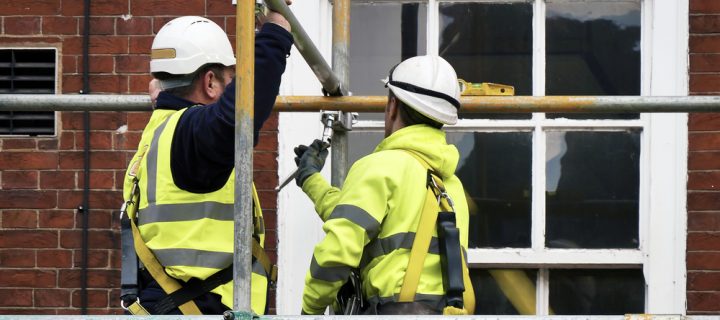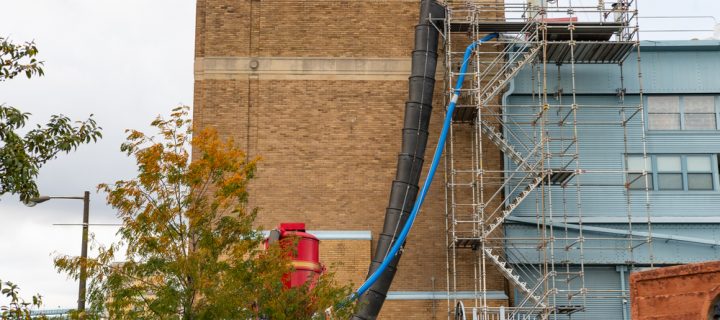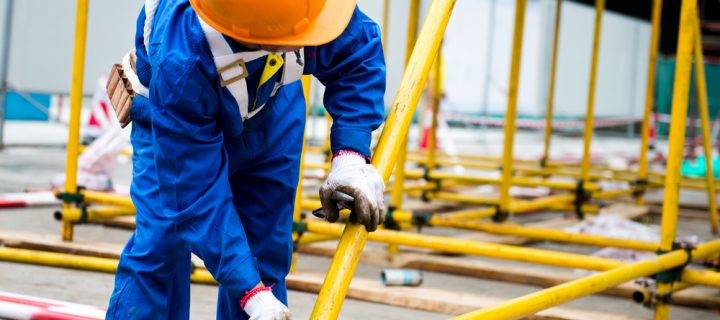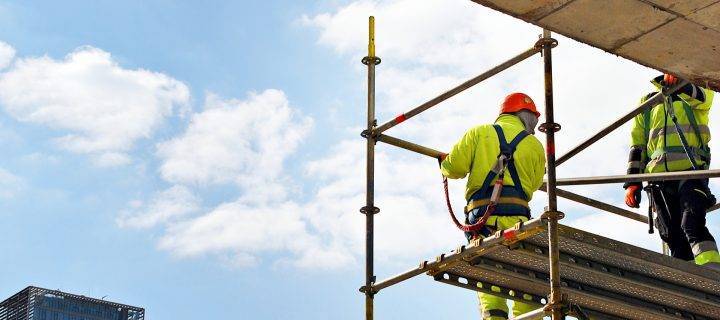The tools you need for scaffolding can often depending on the type of equipment you are going to use and if a scaffold tower is needed. For this blog, Network Scaffold Services will explain all about the fundamental items required for a successful scaffold project. 9 Types of scaffolding equipment 1. Safety Decking – Safety decking is used by scaffolders to walk on and allow workers to safely navigate across the structure. 2. Crossbars – These are the diagonal bars that go across the frame that keeps the scaffold structure in place and provide extra strength. This means the scaffold supports much heavier loads and allows it to be built higher but still safely. Crossbars also provide an additional barrier that prevents anyone from falling from the scaffold. 3. Framing – These are the bars and poles which go across the framing of the structure making up the general structure of the frame. This needs to be regularly checked over a period of time to make sure the condition is suitable for continued usage. Poles that appear to be rusting should be replaced as this is an indication that they are not as strong as they should be. 4. Pins and clamps – These devices are simply used to keep the structure together, and it is integral that they are checked regularly. This is because if one pin or clamp fails or becomes damaged, the integrity of the whole structure is put at risk. 5. Base plates – Base plates are placed under the lower scaffold poles and spread the weight of the structure so the legs of the scaffold put less pressure on the ground and prevent it from slipping. 6. Safety barriers – Depending on how the scaffold is used, added safety features may be needed. Netting may not necessarily be strong enough to prevent someone from falling but can prevent any building equipment from falling off the scaffold structure plus it protects anyone working below. 7. Tape measure and socket set – It may sound obvious, but, a tape measure is essential to ensure the scaffold is built in accordance with the requirements set out in the plan. Additionally, without a reliable socket set or spanner,...
Read Moreabout What are the essential pieces of scaffolding equipment?Construction workers need a platform to move materials and move along to carry out their tasks – which is where scaffolding comes in. It is a temporary framework mainly made of steel with platforms at different heights. If you are looking for scaffold for your next project, Network Scaffold Services is your first destination. It supports both the original structure that is under construction plus the workmen involved. Masons need scaffolding where they can sit and place construction materials when the height of a column, wall or any other structural components of a building exceeding 1.5m. Scaffold can be used for the construction of new buildings, maintenance of an existing structure, access, repair plus inspection. Scaffolding uses in construction Single Scaffolding – Single scaffold platforms are often used in brick masonry works, consisting of a single framework of standards, ledgers and put logs that are temporarily constructed parallel to the wall being worked at. For scaffoldings placed on very tall heights, braces are usually fixed for additional support and help to maintain the stability of the high scaffolding. Braces are fitted cross diagonally with the standards using rope lashing. Double Scaffolding – Also known as mason’s scaffolding because it is widely used for stone masonry works. This type is generally stronger and provides better support for construction works when compared to single scaffold platforms. It features two rows of standards separated by ledgers for better support. Steel scaffolding – Also referred to as tubular scaffolding due to the hollow nature of the steel metals used. The metals are fastened using a special form of steel couples instead of rope lashing. The fastening mechanism consists of prop nuts that hold individual pipes, bolts, nuts and washers plus wedge and clips. The standards in steel scaffold platforms are anchored on square or round steel plates known as base plates by welding, instead of fixing them into the ground. Got any questions? Get in touch now If you have any questions about the different types of scaffold, please do not hesitate to contact Network Scaffold Services...
Read Moreabout Do you know the different types of scaffolding?Here at Network Scaffold, we consider the use of scaffolding to be an integral part of the design and survey process for glazing providers. For this blog, we look at the main criteria for the requirements for scaffold. The main reasons for scaffolding The two main factors in deciding on scaffold structures are the safety of glazing installers plus the ability to create the best professional finish possible. The safety of fitters cannot be overstated, with some companies working regularly with us as a scaffold partner to create an overall quote for window installation. In a nutshell, glazing installers are constantly trying to make sure installers are safe and achieve an excellent finish to their work, which is sometimes only possible using scaffolding. Many different types of properties present numerous challenges, including types of housing that can be extraordinarily diverse in terms of size, age, construction, ground conditions and glazing apertures. Here are some of the criteria incorporated into the decision to use scaffold structures. Height – If the work is above first-floor level it is recommended to use scaffold. Dormer windows – Dormer windows are often set back from the property roofline which means they can only be safely reached with scaffold. Lintels – When a steel lintel above a window is being installed, scaffold will normally be used unless the window is at ground floor level. Windows above conservatories or porches – Any type of structure that prevents installers from being able to put a ladder up to reach a window is considered an obstruction that requires scaffold structures. By systematically considering each of the aspects above, window installers will be able to decide whether the scaffold is needed and inform their clients in due course. Got more questions? Please contact us now If you have any more questions about using scaffolding for window replacement and installations, please do not hesitate to get in touch...
Read Moreabout Do I need scaffolding to replace my windows?Network Scaffold work with a number of leading demolition contractors in Derby and Nottingham. Our scaffolding work covers a wide range of intricate, complex demolition, dismantling and deconstruction projects. The majority of these projects are in areas where space is limited. As standard, we also offer scaffolding protection and support for the duration of the demolition project. The demolition process explained A building’s demolition brings significant hazards, especially when the building or structure is so close to other buildings and live working environments. The type of demolition scaffold we offer is subject to the contractor’s chosen demolition method, which often requires full encapsulation of the building incorporating dust and falling debris measures. With most demolition work, a degree of asbestos removal invariably occurs, and we can provide fully licensed scaffold structures. Building encapsulation for top-down demolition With a number of local authorities redeveloping large housing estates, it involves the demolition of high-rise tower blocks. These blocks are very close to each other with the space around them being quite restricted. The most commonly used method of demolition is ‘top down’ which involves demolishing the building floor by floor. When conventional demolition occurs close to live environments, buildings, roads and railways, Network Scaffold will provide scaffold structures. We also provide safety decking for sections of buildings and structures that will allow workers to safely navigate the area without fear of falling. The disciplines of health and safety Here at Network Scaffold, the health and safety of workers and the general public is an integral part of our management function. We will always comply with all applicable laws and regulations and look to adapt our management resources to the latest recommendations. Get a no-obligation scaffolding quote from Network Scaffold If you are planning a demolition project soon, contact Network Scaffold Services today for a no-obligation quote for our scaffold structures. We have also recently added plastic hoarding and safety decking to our portfolio, giving our clients the full range of...
Read Moreabout Demolition scaffolding services from Network ScaffoldConstruction sites have helped to create a lot of the infrastructure we see around today, including towering buildings and multi-story homes – with all of these structures erected using scaffolding. Scaffold from companies such as Network Scaffold Services allows workers to reach new heights while performing different buildings plus maintenance and repairs. According to industry statistics from OSHA, 65% of all construction workers perform some type of work on scaffolds each year. Put simply, they are a staple on construction sites for many different projects. We will tell you all you need to know about using scaffolds on construction sites for this blog. What are the dangers associated with scaffolding? The most common injury associated with scaffolds, is falls, with some structures becoming unstable due to adverse weather conditions. Problems can also arise if the parts are not properly secured or attached during assembly. Besides falls, improper planking can lead to injuries, such as – Wear and tear due to exposure to the elements Improper or incomplete inspections Overloading of people or equipment How to stay safe Before using scaffold structures it is important to receive training from a competent and qualified person. During training, the instructor needs to go over the proper use of scaffolding and handle certain materials plus load capacity. Make sure that you pay attention and retain the information as if any new hazards arise you will be ready. Additionally to training, make sure the scaffold is inspected by a qualified professional before using. Remember to always wear a hard hat when working on or under a scaffold plus some sturdy work boots.’ Contact us with any questions If you have any further questions about scaffolding, please do not hesitate to get in touch with Network Scaffold Services. Our team of experienced professionals will be more than happy to...
Read Moreabout Using scaffolding on construction sitesHere at Network Scaffold Services, we know all about the best way to work with scaffolding. If you have recently decided to undertake a construction project that requires a scaffold frame, it is important to know as much as possible before you start. For this blog, we will give you five handy tips to ensure your building will be safe and look fantastic once work is completed. Having confidence in your scaffolding structure 1) Plan ahead – Planning ahead makes your job easier and ensures all your equipment to complete the structure is readily available. This means that you will not be missing any important pieces and your structure meets all health and safety legislation. Having a few sketches of the proposed construction allows you to visualise the structure, so when placing orders for materials you will get everything you need. Sketches will also help explain the structure to the scaffold team during a briefing. Planning ahead ensures you have met all necessary requirements plus you will save time and money. 2) Construction ground – The foundations and conditions of the ground when building a scaffold is very important. Construction on uneven ground can be dangerous. Making sure the ground is level means the scaffold can be supportive even when conditions are wet. 3) Safety is a top priority – Safety is our number one priority at Network Scaffold Services. Making absolutely sure structures are safe and stable limits the chances of accidents on-site. Protective equipment such as hard hats, long sleeves, gloves, and goggles need to be worn when working with the scaffold. Protective equipment also needs to be used on scaffolding, such as safety rails and access gates to prevent anyone from falling from a height. 4) Creating a safe structure – Using safety decking gives you a safe working platform. The decking fits tightly together and ensures materials will not fall through the cracks to any other level when in use. Scaffolding also needs to be tied to the property for maximum protection. 5) Inspect scaffold – Scaffolding needs to be thoroughly checked out and inspected before being used. An inspection log has to be completed daily, detailing deterioration or signs of broken or partially damaged...
Read Moreabout 5 Ways to stay safe using scaffolding
